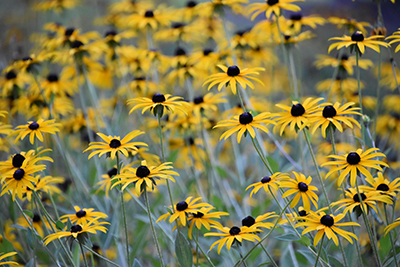Living in an arid or semi-arid climate poses many challenges. Higher elevations and more rugged landscapes offer less water, dry climates, and plant-scorching rays from the sun. This can make selecting plants for your garden quite the endeavor! There is a solution to all of this: xeriscaping.
What is xeriscaping? Xeriscaping is the integration of landscaping an area in a style that requires little or no irrigation. This can be done through a thoughtful selection of drought-tolerant, xeric, and native plants, reducing the size of your lawn, water-directing irrigation techniques, low-water irrigation systems, retaining water where needed, and embracing the use of pathways, rocks, stones, sculptures, and structures throughout the garden.
No Lawn? No Problem!
To clarify, xeriscaping does not mean you cannot have a lawn, but it does mean significantly reducing the size of your lawn. Most traditional grasses used in an average American lawn require a lot of water, about an inch of water per week; depending on the size of your lawn this could amount to thousands of gallons of water a year and a utility bill that can put a real dent in your budget. Some regions in the country experience adequate rainfall to justify the maintenance of a lawn; however, in many places across the US from the dry, mountainous western states to the blazing-hot deep south, scorching summers and weeks with no rain are commonplace. Eliminating or reducing the size of your lawn is the easiest way to save money and conserve water for other needs.
Not convinced about ditching the grass? There are other solutions! Planting native grass species that are already adapted to your region's climate can significantly curb your water usage. Typically grown from seed, these alternative lawns are comprised of a combination of native or adaptive grasses and perhaps some broadleaf species like clover and yarrow. Deep-rooted and growing in widening tufts rather than creeping stolons or rhizomes, they may take longer to fill in, but once they do, they can get by on average rainfall and require little to no mowing.
Using the Water You Have
When it does rain, make sure your garden is taking advantage of it. Redirecting water flow from rainstorms can be an easy and free way to make sure your vegetation is meeting its watering requirements. Here are some options for utilizing natural rainfall:
- Check dams are small dams that slow the flow of water during rainstorms. These systems will slow the flow of water as it continues downhill, giving it time to soak into the soil. They can be discreetly incorporated into many yards, and require less digging than other water-saving options.
- Instead of mounding soil to produce a garden bed, dig into the ground to create a rain garden. This reduces water runoff and plants that may be thirstier than others can do well in these types of beds. It should be cautioned that rain gardens should be established away from the house so as to not invite water into the basement or foundation of the home, and at least 50 feet away from any septic tanks that may be on the property.
- Grading or sculpting the soil on your property is another excellent way to retain the rainwater falling on your land. This can be done through berming and microbasins. Acting as a miniature dam, when water pools behind the bermed soil, microbasins form giving the water time to permeate the soil. Once the microbasin is full the water overruns the berm and moves downhill into the next one. This works well for nearly level or shallow slopes. Avoid constructing these near your home and never in the path of a drainage channel where water flows swiftly during a rainstorm, as this can lead to flooding.
- When properties sit on a steep slope there are likely problems with soil erosion and most likely dry soil that cannot hold water due to the quickness in which water flows down it. The solution to retaining water in these circumstances is building a terrace or a series of terraces. Terraces are flat areas carved into a hillside, much like steps, but much wider. These large flattened areas slow down water flow significantly so plants can absorb water and the soil isn't eroded away as quickly. This solution can prove more costly but is arguably one of the more effective and long-lasting solutions to utilizing the water mother nature supplies us with.
There are many ways to utilize natural rainfall, understanding the slope of your yard and where water collects is an integral part of it. Be sure to observe where water pools or runs off next time it rains to determine which method is best for you.
Choosing Vegetation

With the size of the lawn now reduced and a thoughtful mapping of where water flows through your yard, you can now begin the fun part, picking your flowers! When plotting what flowers would be best to incorporate in the xeriscape of your dreams, start with native flowers and plants; they have adapted to the climate and soil conditions where they naturally occur and therefore will require less supplemental water once established. Even in high Sierra environments like Botanical Interests' home state of Colorado, native plants can bring vibrant color and beautiful texture and shapes to your garden. Bright blue columbines and lupines stand out against soft, prairie 'Blue Grama' Grass while hardy desert dwellers like yucca add a great visual texture against softer ground cover like iceplants and stonecrops.
Apart from native plants, there are many well-adapted plants that can still thrive in your region's environment. To continue with our home state as an example, Colorado residents should consider drought-tolerant varieties (with most of Colorado only receiving 17" of rainfall on average a year) like bird's eye, blue flax, African daisies, desert marigolds, and Mexican hats - all found in our Water-Wise Garden Flower Mix. Drought-tolerant varieties like these do well in most zones 3 - 9 and can help you seriously slash the water bill in half. There are even some drought-tolerant varieties like our Bright Lights Blend Cosmos or our 'Steel Blue' Sea Holly that prefer drier environments and don't seem to mind neglect!
Structures Around the Garden
Filling every corner with plants sounds wonderful but in order to access those flowers, shrubs, and trees when they do need some tending to, we want to consider what other structures may create a space to walk, sit, and fill in those holes where plants will not go.

Rocks, stones, and permeable pavement are beautiful and natural ways to add visually stunning compliments to the vegetation planted around them. Local stones can create an understated pathway with adaptable moss lacing the edges. Lichen-covered boulders can create shade for sections of the garden and simultaneously produce a micro-climate of moisture around them, as they do a great job of both attracting and retaining water beneath their soil. They also can be used as natural benches, not taking away from the natural setting of your xeriscape space.
Apart from the utility these structures provide, there are plenty of opportunities to be creative when designing a xeriscaped yard. Sculptures and art installments can occupy space where flowers, trees, or shrubs cannot go and can create nice focal points for your garden. Mirrors and water-inspired features can evoke feelings of serenity and bliss in an otherwise water-free environment. However, water features are not out of the question! Small water features amongst a collection of drought-tolerant vegetation are still a significant reduction of overall water usage, especially if in a shady spot. Even watering stations and bird baths can make a perfect addition, helping welcome birds and other pollinators to their new oasis.
Speaking of shade, canopies, shade trees, and structures such as pergolas can provide refuge for yourself and guests to enjoy a respite from the sun, while also shading parts of the garden, helping reduce evaporation of water. These structures are also great support for trailing drought-resistant plants like our Single Blend Trailing Nasturtium.
Although a lot to consider, xeriscaping has endless possibilities and provides homeowners in drier climates the opportunity to flex their creative muscles when designing a yard that is not so dependent on water where water is already hard to find. If we can help reduce our use of water and embrace the regional environment where we reside, we can help direct water to places that need it the most.
Incentives and Resources
Many cities in the Western United States are offering financial incentives and educational resources to encourage homeowners to install water-wise landscapes. Check-in with your state and local government to see what resources are available to you!
Written by Lauren Wetenkamp


